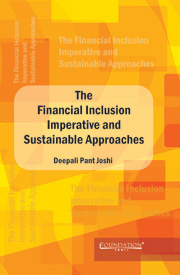Book contents
- Frontmatter
- Contents
- Foreword
- Acknowledgment
- 1 An Overview on Development
- 2 Financial Inclusion: The Nature and Extent of the Challenge
- 3 Financial Inclusion: The Indian Perspective
- 4 Tackling Financial Inclusion and RBI Policy: Responses and Voluntary Initiatives of Banks
- 5 Microfinance Experience and Other Institutional Approaches
- 6 Policy Response Committee on Financial Inclusion
- 7 International Experience in Promoting Financial Inclusion and Policy Responses
- 8 The Way Forward – Determinants and Macro Policies
- Appendix
- Bibliography
- Index
4 - Tackling Financial Inclusion and RBI Policy: Responses and Voluntary Initiatives of Banks
Published online by Cambridge University Press: 05 June 2012
- Frontmatter
- Contents
- Foreword
- Acknowledgment
- 1 An Overview on Development
- 2 Financial Inclusion: The Nature and Extent of the Challenge
- 3 Financial Inclusion: The Indian Perspective
- 4 Tackling Financial Inclusion and RBI Policy: Responses and Voluntary Initiatives of Banks
- 5 Microfinance Experience and Other Institutional Approaches
- 6 Policy Response Committee on Financial Inclusion
- 7 International Experience in Promoting Financial Inclusion and Policy Responses
- 8 The Way Forward – Determinants and Macro Policies
- Appendix
- Bibliography
- Index
Summary
Financial exclusion broadly relates to a lack of access to a range of financial services. Several of those who belong to the lower income groups are unable to access mainstream financial products such as bank accounts and bank loans. This financial exclusion imposes real costs on them and their families' implications become graver when they prompt social exclusion and lock families in a cycle of perpetuity of debt, poverty and exclusion. An inclusive financial sector per contra, is one which offers a range of financial services to the entire population of a country and addresses issues of economic growth with equity. The RBI as the Central Bank has always been engaged with building a legal and regulatory environment for the financial sector which broadens access to its services. The processes of globalisation and faster economic growth have spurred the need for affirmative action for inclusive growth and to build social safety nets through increasing financial inclusion. Growth with equity has been the overriding policy concern which has governed the direction of banking policies. In India, in the context of initiatives exercised for extension of the penetrative outreach of the banking sector, the mode of financial sector development discussed in the previous chapters too has been characterised by the following features.
Macro Policy Initiatives
Financial inclusion was sought to be achieved through an increase in bank branches which led to an expanded cooperative network and new organisational forms like regional rural banks.
- Type
- Chapter
- Information
- Publisher: Foundation BooksPrint publication year: 2011



